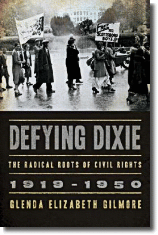
She applied the "Page 99 Test" to her new book, Defying Dixie: The Radical Roots of Civil Rights, 1919–1950, and reported the following:
Defying Dixie is about those people in the South who opposed segregation and white supremacy from 1919 though 1950 and who paved the way for the Civil Rights Movement of the 1950s. The first third of the book focuses on Communists, who stood almost alone in espousing integration, social equality, and full political rights for African Americans in the 1920s and early 1930s. It's not easy to write compellingly about the details of Communism theory on the ground in the South. The records were secret, people used aliases, and they changed approaches and revised organizations based on national and international policies. I used the Soviet archives in Moscow and matched that information to local southern sources. Page 99 is about the nuts and bolts of Communist organizing in the South and why black southerners joined the party. It's more organizational and less personal than most of the narrative because it documents a change in Communist policy toward organizing African Americans. Page 99 uses local stories to illustrate international politics and introduces human characters to exemplify complicated political ideas. To answer Ford Madox Ford, it's representative, but it's not comprehensive.Read an excerpt from Defying Dixie and learn more about the book at the publisher's website.
Page 99:
over some commercial transaction.1 Moreover, poor black transients looking for work often found themselves accused of crimes by people they had never met in places they had only visited. The Communists realized that white southerners used the criminal justice system to enforce their political economy. Lynching a black man taught other black men to stay in their places at the bottom of the economic ladder.
Organizing around issues such as lynching helped bring southern African Americans into the Party. When Otto Hall left Gastonia he traveled to Baltimore, Atlanta, Richmond, Birmingham and throughout North Carolina. He hoped to turn radical pre-existing black organizations into American Negro Labor Congress chapters.2 At the close of 1929, the ANLC had forty-six locals, including twelve in the South, an amazing increase over the five northern locals it had had when the Gastonia strike began. The next year, “for the first time in the five years’ history of the A.N.L.C. since its founding in Chicago in 1925, a delegation came from the South.” Hall had succeeded where Lovett Fort-Whiteman had failed.3
New ANLC branches should have furnished black CP members to integrated Party units, but getting the local white Party members to accept black people proved a difficult task. For example, in Norfolk, Virginia, Party members were Jewish small businessmen who conducted meetings in Yiddish. A young white Communist organizer built a union among black women who worked in a bedspring factory there, only to be charged with a violation of Virginia’s law against “conspiracy to incite the colored population to insurrection against the white population.”4 Moreover, he reported, the local Jewish Communists adopted an “open antagonistic attitude towards Negro Comrades.” The practice of interracial Communism proved too much for the Jewish members, who feared their own arrests would come next. They voted to “disband the branch in the face of all the terror.” The Party called them “petty-bourgeois elements” and expelled them.5 The Party had to impress the Negro Policy’s importance on their white members.
The interracial League of Struggle for Negro Rights (LSNR) was a step in that direction. It replaced the all-black American Negro Labor Congress with an organization that would be “more broad and all-inclusive,” and include “white workers standing on the program of Negro Liberation.”6 By the end of 1931, ferreting out racism in the Party
--Marshal Zeringue



